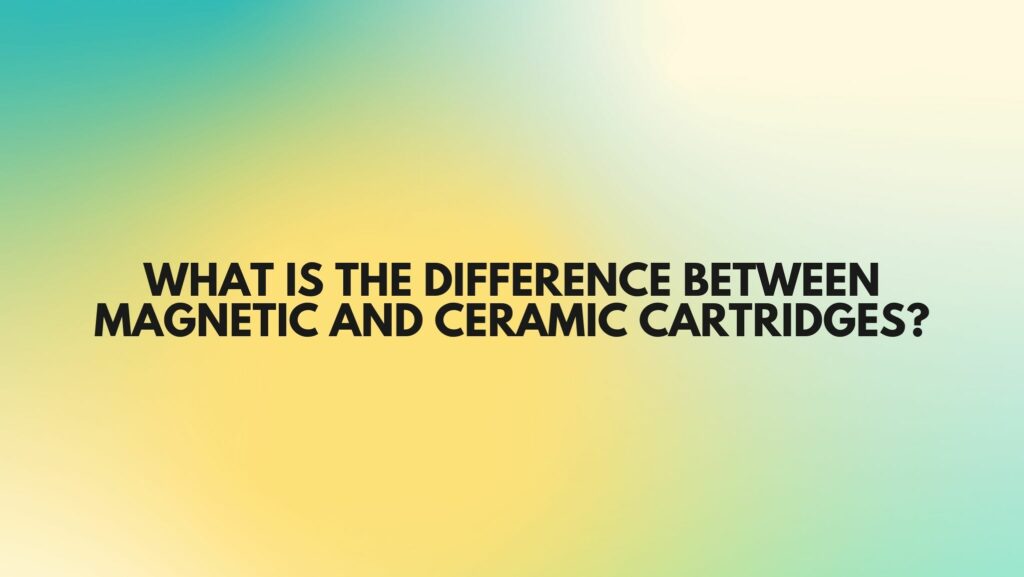A vital component of any turntable setup is the phono cartridge, responsible for translating the analog grooves on a vinyl record into electrical signals that can be amplified and played through your speakers. There are two primary types of phono cartridges: magnetic and ceramic. In this comprehensive article, we will explore the key differences between magnetic and ceramic cartridges, their unique features, and the factors to consider when choosing the right one for your turntable.
Understanding Magnetic Cartridges
Magnetic cartridges, commonly referred to as Moving Magnet (MM) or Moving Iron (MI), are the more popular and widely used type of phono cartridges. Here are their main features:
- Design: In magnetic cartridges, a tiny magnet is attached to the cantilever, which moves within a fixed coil of wire. As the stylus traces the grooves of the record, the magnet’s motion generates a voltage in the coil, which is then amplified by the phono preamp (phono stage).
- Output Voltage: Magnetic cartridges generally produce a higher output voltage compared to ceramic cartridges. This makes them compatible with a broader range of phono preamps and amplifiers.
- Versatility: Magnetic cartridges are known for their ease of use and versatility. They are relatively forgiving in terms of setup and can be used with a variety of turntables.
- Sound Quality: Magnetic cartridges offer good sound quality, with options available to suit different budgets and audiophile preferences. They are particularly well-regarded for their balance and tracking ability.
Understanding Ceramic Cartridges
Ceramic cartridges are an older and less common type of phono cartridges but still have their place in the world of vinyl. Here are the main features of ceramic cartridges:
- Design: Ceramic cartridges use a ceramic element as the transducer. The stylus’s movement creates mechanical vibrations in the ceramic material, resulting in electrical signals.
- Output Voltage: Ceramic cartridges produce a lower output voltage compared to magnetic cartridges. This lower output often requires a specialized ceramic phono preamp for proper amplification.
- Durability: Ceramic cartridges are known for their durability and resistance to wear and tear, making them a good choice for jukeboxes and public listening environments.
- Sound Characteristics: Ceramic cartridges tend to have a distinctive sound character, characterized by a bright, vibrant tone. They emphasize the midrange and highs and can provide a unique listening experience.
Choosing the Right Cartridge for Your Turntable
When deciding between a magnetic and ceramic cartridge for your turntable, consider the following factors:
- Sound Preferences: Your choice should align with your preferred sound characteristics. Magnetic cartridges offer balanced and detailed sound, while ceramic cartridges tend to provide a bright and vibrant sound.
- Equipment Compatibility: Check whether your turntable, phono preamp, and amplifier are compatible with the output voltage and type of cartridge you’re considering.
- Budget: Magnetic cartridges come in a wide price range, making them suitable for various budgets. Ceramic cartridges are often more affordable but may require a specialized phono preamp.
- Usage: Consider how you plan to use your turntable. If it’s primarily for personal listening, magnetic cartridges are versatile and offer high-quality sound. If you’re setting up a jukebox or require a robust, durable cartridge for public use, ceramic cartridges may be suitable.
Conclusion
Magnetic and ceramic cartridges each have their unique characteristics and applications. Magnetic cartridges are the go-to choice for most turntable users due to their versatility, good sound quality, and compatibility with a wide range of equipment. Ceramic cartridges, while less common, offer a distinct and vibrant sound character and durability. Your choice should align with your preferences, equipment compatibility, and how you intend to use your turntable, ensuring you get the best possible vinyl listening experience.

